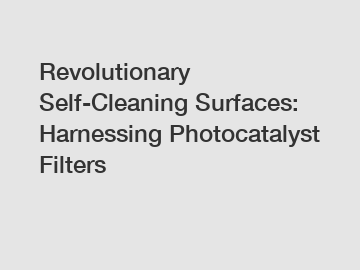Feb. 02, 2024
Environment
Revolutionary Self-Cleaning Surfaces: Harnessing Photocatalyst Filters.
Keeping surfaces clean and free of dirt, dust, and stains can be a never-ending battle. However, imagine a world where surfaces can clean themselves effortlessly, eliminating the need for constant scrubbing and maintenance. Thanks to groundbreaking advancements in technology, this seemingly far-fetched idea has become a reality. Revolutionary self-cleaning surfaces, powered by photocatalyst filters, are taking the world by storm with their ability to break down organic matter and keep surfaces pristine. In this article, we will explore how these innovative surfaces work and the benefits they offer.
How do self-cleaning surfaces work?

Self-cleaning surfaces rely on the process of photocatalysis to break down organic matter on their surfaces. Photocatalysis is the acceleration of a chemical reaction through the absorption of light by a photocatalyst. In the case of self-cleaning surfaces, the photocatalyst is typically titanium dioxide (TiO2), a compound widely used for its photocatalytic properties.
When TiO2 is exposed to light, it undergoes a reaction that produces powerful oxidizing agents, such as hydroxyl radicals and superoxide ions. These oxidizing agents are highly effective at decomposing organic compounds, including dirt, mold, bacteria, and even stubborn stains. Not only do self-cleaning surfaces break down organic matter, but they also have the ability to cause the decomposition of volatile organic compounds (VOCs) and neutralize unpleasant odors.
Applications and Benefits.
Self-cleaning surfaces find application in numerous industries and settings, from hospitals and public transportation to residential buildings and outdoor spaces. One of the key advantages of self-cleaning surfaces is their ability to maintain cleanliness without human intervention. This dramatically reduces the time and effort required for cleaning and maintenance, making it a cost-effective solution in the long run.
Additionally, self-cleaning surfaces contribute to improved hygiene and safety. By continuously breaking down organic matter, they inhibit the growth of bacteria and other pathogens, reducing the risk of infections and diseases. This is particularly beneficial in environments where high levels of cleanliness are essential, such as healthcare facilities or food processing plants.
Furthermore, self-cleaning surfaces are environmentally friendly. Since they eliminate the need for harsh chemical cleaning agents, they reduce the release of harmful substances into the environment. Additionally, the self-cleaning function can help preserve the appearance and longevity of surfaces, reducing the need for replacements and minimizing waste.
Conclusion.
Revolutionary self-cleaning surfaces, driven by photocatalyst filters, have transformed the way we think about cleanliness and maintenance. With their ability to break down organic matter and prevent the growth of pathogens, these surfaces offer a range of benefits in various industries. From reducing cleaning time and costs to improving hygiene and environmental sustainability, the potential of self-cleaning surfaces is immense.
If you are interested in implementing self-cleaning surfaces or learning more about their applications, contact us today. Our team of experts can provide you with the necessary information and guidance to unlock the benefits of this innovative technology. Embrace the future of cleanliness and discover the wonders of self-cleaning surfaces.
Contact Us.
To learn more about self-cleaning surfaces and their applications, please contact us at [insert contact information]. We look forward to assisting you with your inquiries and guiding you through the possibilities of this revolutionary technology.
Are you interested in learning more about air blower filters, photocatalyst filter manufacturer, photocatalyst air filter supplier? Contact us today to secure an expert consultation!
If you are interested in sending in a Guest Blogger Submission,welcome to write for us!
All Comments ( 0 )